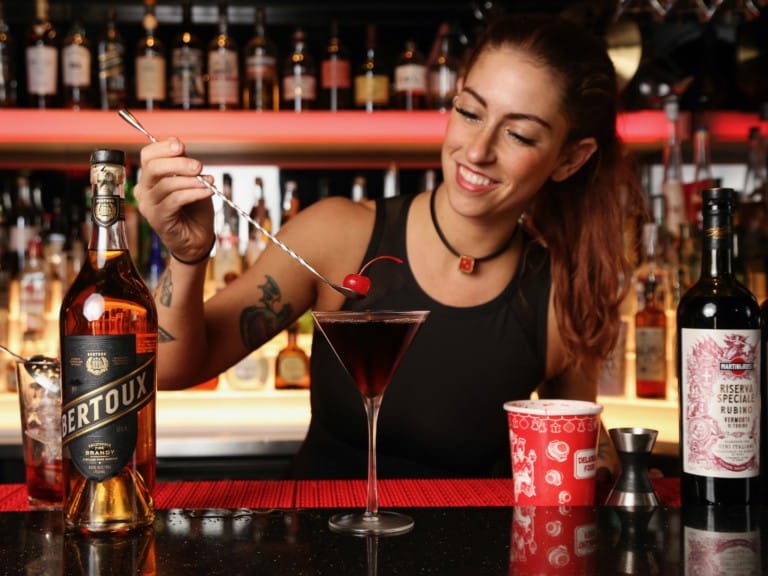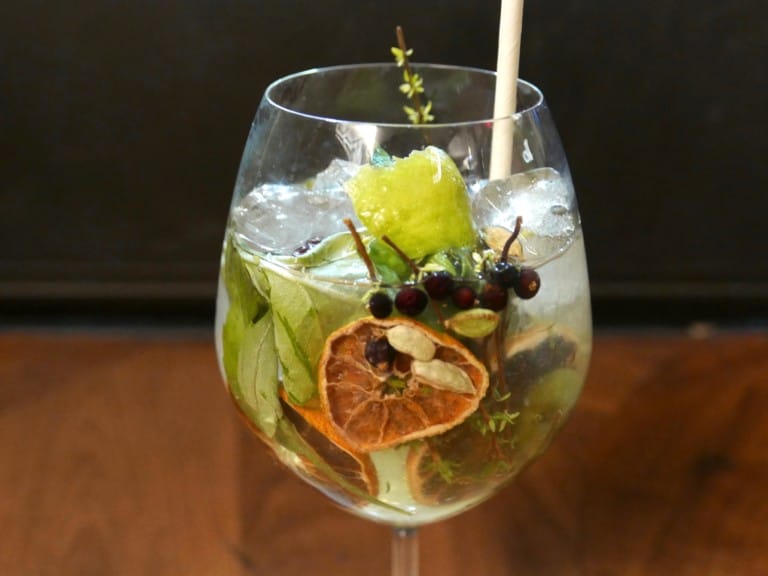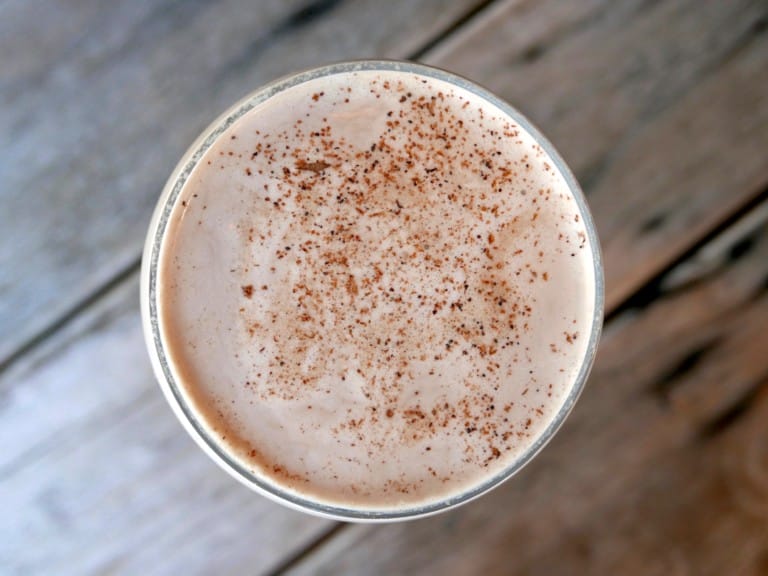To professional bartenders and people who enjoy cocktails on a regular basis, Dale DeGroff hardly needs an introduction. The New York City based bartender goes by “King Cocktail” and helped to lead the cocktail renaissance in America. DeGroff worked behind the bar at legendary establishments like The Rainbow Room before co-founding the Beverage Alcohol Resource (B.A.R.) spirits and mixology training programs and The Museum of the American Cocktail. We recently met in Santa Monica, where he discussed what he looks for in a bar, his favorite bars in New York and Los Angeles, his long-term relationship with Los Angeles and much more.
What is it that you look for in a bar when you go out?
Friendly bartender. I can forgive a lot of sins, and I also look for surroundings of substance. It can be anything from a $4 million buildout to a trashy bar in the subway. It depends. Surroundings of substance have a way of getting under your skin, whether they’re expensive or cheap.
McSorley’s Old Ale House is one of my favorite bars in the world, and they only serve two things, light ale and dark ale. It has real surroundings of substance and has been there for over 100 years. Just things were accidental over the years that couldn’t really be recreated by a design firm. For example, there are wishbones hanging on the old gas lights. They’re turned to electric now. Some of them look like they’ve been there forever because they have stalagtites of dust hanging down off ‘em. My wife was drawing the owner of the place one time – a guy named Maher. Mr. Maher is an Irishman, obviously. I didn’t know he was the owner at the time. I just went up to the bar to ask his permission to use the drawing that she had done in a future book, and it turned out he was the owner. I said, “Oh, nice to meet you. I’ve been coming here for years and never knew who owned the joint.” He said, “Well, I haven’t always owned it,” and told us the story how he ended up owning it, which ended up in the book, and it’s a marvelous story. But I asked him a question why there were wishbones hanging from the lights. He said, “You don’t know?” I said, “No, I don’t.” He said, “It was a tradition here long before I came here. I don’t know when it started, maybe the Spanish-American War, but when fellas from the neighborhood went off to war, they’d come in here and hang a wishbone up, and when they’d come back, they’d snap it for good luck. These are the fellas that didn’t come back.” So how do you recreate that?
When I say surroundings of substance, it doesn’t have to be a fancy buildout or anything like that, just things about the place that are significant and interesting and unusual. That’s the way New York is. Neighborhood bars in New York – especially the older ones that have been there for awhile – are the scene of most of the drama that takes place in the lives of the regulars – because they have their weddings there, their funerals there. They celebrate a lot of their good and bad times in these places. A lot of people there are their extended family. These are the significant things that happen in our saloons around America. It’s just a tradition that’s grown up in the last couple hundred years.
What are the places that you made a point to stop at this time around on your trip to Los Angeles?
First, I made a beeline for Musso & Frank’s. Manny [Aguirre]’s a bartender there who’s an old, old pal of mine, and I just like the looks of the place. Can you imagine what it must have been like for someone who came to Hollywood in 1919, when they just opened their doors and I don’t know if Hollywood even had paved streets then. Imagine. It must have looked like a palace to them. It was this incredible place with beautiful woodwork and a beautiful buildout. Still the woodwork looks good and they’ve sort of maintained it. It’s not really threadbare, that’s the wrong word, but it shows its age. Still, I went there to meet friends ostensibly to go for a drink. We were going to go to Loteria next door for dinner. We got talking and passed our reservation time, so when we went to Loteria, they’d given away our table, so we just went back to Musso & Frank’s and ate in the bar. I’m so glad we did. I was just sitting in that bar, with that wacky, endless menu, with all the crazy things you can order off of it, and the people we ran into at the next table, and the people at the bar. It’s a scene of real life.
Do you always prefer to go back to places where you know people?
Not necessarily. When I was just in Chicago, I went to a great saloon that goes back to the days of Al Capone. As a matter of fact, his booth was there, and it’s a place like Musso & Frank’s that showed its age but was also quite charming. It had a whole new younger crowd going to it and it turned into a jazz club. It had a nice stage where they used to have shows, obviously, years ago. And two Hammond organs, one behind the bar where the trio sometimes plays, and one on the stage. The first time I went it was with David Wondrich because he wanted to do something for Esquire magazine about it. It’s on South Broadway, a very famous place, been there forever. We were kind of alone at the bar and the bartender was a guy who had worked there a lot, then retired, then he came back to work one or two days a week. He got sort of sucked back into it. He was a really cool guy. He told us stories of how there were tunnels underneath with escape routes for Al and his gangster buddies, one going this way, one going that way, one came up in the theatre across the street. And that they used to have poker games down there and they used to have prostitutes down there in the old days when it was a speakeasy. It had this great history. I came back a second time just to go hear the music, and sat down at the booth next to Al Capone’s booth. That was a brand new place. David suggested we go there. He’d heard about it. The Green Mill. Quite a famous place in Chicago.
One of the things you do is ask several people, “What’s the one bar I don’t want to miss while I’m in town?” Or while I’m in this neighborhood? You get various answers and usually the same names will start popping up. If somebody asked me that and I’m in New York, of course I’d say P.J. Clarke’s. McSorley’s Old Ale House. Pegu Club. Clover Club. Employees Only. I’d say the lobby of the Algonquin Hotel, or the Blue Bar…There are numerous places, depending on the neighborhood in New York, depending on where you’ll be, and depending on where you were and what I thought would appeal to you.
Are there any common threads between those establishments?
You know, the common thread is that they all treat you right. They don’t all offer the same things. You get different kinds of drinks in different kinds of places. Some places offer the fancy drinks, and some places don’t, but the common thread of course is that there are people who understand where they work and like it. They’re doing what they want to do, so consequently, the people that go in there, they feel that. You feel that these people are happy where they are, they have pride in what they do. They make it comfortable for you to be there.
You reference a classic style bars. How do you feel about the places that are modeled as speakeasys?
I don’t care. To be honest with you, I’ll tell you the story of the beginning of that, I mean the modern revival of that. Actually it was accidental, because people give Sasha Petraske some credit, partial credit, for this idea of a speakeasy, because of Milk & Honey. But in fact Milk & Honey was right across the street from my friend’s loft, and I used to go to his loft all the time. He was a musician/jewelry designer. And when he discovered the place, there had been a mahjong, Chinese gambling place in the basement of this tenement for years. One time he was walking his dog and there were some young people coming out of there, and he said, “What the hell are you doing in there?” And they said, “Well, there’s a bar in there.” He said, “Get the hell out of here. When did that open?” “About a week ago.” “Really?” So he goes in there with his dog and Sasha’s behind the bar, had just opened. My friend Joe says, “You know, one of my friends is a real good bartender, kind of a famous guy from the Rainbow Room. His name is Dale DeGroff.” “Oh, Dale DeGroff,” Sasha said. “Make sure you bring him in when he’s here next time. I have some questions for him.” So I gave Sasha some books and talked to him on several visits. I’m actually the one who brought in Jonathan Downey from London and the three of us together opened Milk & Honey London. But Sasha’s speakeasy really never intended to be a speakeasy. Sasha intended to keep his doors open and let anybody who came in, come in. He would ask people who were bloggers or journalists – this was some years ago, there weren’t as many bloggers – not to write about it. He said, “I really don’t have the space. I’m not really a bartender, I’m just working this out as I go along. I don’t really want crowds of people in here, and as you can see, I only have 24 seats. I’ve got people living upstairs. It’s a tenement building on a residential street and we’re the only bar. I prefer you not make a big deal out of this.” Well, in fact somebody did, and all the sudden there’s this secret little rendezvous place everybody wants to go to, so there were crowds of people gathering in front of the place. So he locked the doors, put a little camera there, and a buzzer, and if he knew you, he’d buzz you in. Then after awhile he figured “That’s not fair, let me have a membership thing.” He got the idea of a loose membership, you know, regulars, and then eventually the phone number, which kept changing over and over again. That’s really how this whole speakeasy thing happened. It happened accidentally. He never intended to lock his doors, but people thought it was cool, and people wrote about that. So other bars started doing something similar, not really locking people out necessarily, but making it more by-reservation for the smaller places. At places like Employees Only, you didn’t have to have a reservation at all. You had plenty of room inside, but there was no real sign. You had a woman who told fortunes sitting in a window and a little E.O. over the door. For all intents and purposes, it really didn’t say bar anywhere, you just had to be in the know to go there. So people like that idea, which is how this whole speakeasy thing started. People are just turned on by the fact of having the inside track.
Do you feel like there are other especially good representations of that style of bar?
PDT is another good one. It’s too small. They’re all too small, or most of them are too small. But then there are other ones that in the style of the era that do fashionable, lounge-y drinks from that era that just have their doors open. Clover Club in Brooklyn. The Flatiron Lounge. Those guys from Employees Only opened a place called Macao Trading Company, which has a sign out front. You’re seeing them opening all around the country, those kinds of places, and it’s really nice to see. Even corporate people have hired some of these guys to try and reproduce that feeling. The W Hotels are trying to get that sort of feeling in their bars and have hired Sasha to do a few of them. They don’t quite get it. The W Hotels have always been infamous for terrible bar service. Lots of style and very little substance types of places. In fact the craft bartending movement is starting to sweep into the general marketplace now, so you’re seeing it in much larger, more interesting venues, and that’s good. Not more interesting in the sense that Milk & Honey wasn’t interesting, but larger places where there’s more money involved, the design’s more interesting, and the buildout’s a little more interesting. You’re seeing that happen on a much larger level, and that’s a good thing, as long as they keep in mind that it’s all about the drinks and the customers.
In terms of the New York cocktail scene, do you feel like it’s saturated, or is there still room for growth? And if so, what sort of growth do you expect?









Blog Comments
mattatouille
December 23, 2010 at 4:47 PM
Best bartender interview EVER. I love DeGroff’s The Essential Cocktail – a must read for any cocktailian. By the way, you spelled Polo Lounge, Polio Lounge. Big difference 🙂
Joshua Lurie
December 24, 2010 at 11:30 AM
Mattatouille,
Glad you liked my interview with Dale. Thanks. He certainly has the historical perspective and plenty of insight. I’m pretty sure he meant to say Polio Lounge, which is apparently a longtime nickname for the establishment.
Tweets that mention Food GPS » Q&A with Dale DeGroff, King Cocktail -- Topsy.com
December 23, 2010 at 4:05 PM
[…] This post was mentioned on Twitter by foodgps, Caterham Business. Caterham Business said: Q&A with Dale DeGroff, King Cocktail http://bit.ly/eHz2co […]